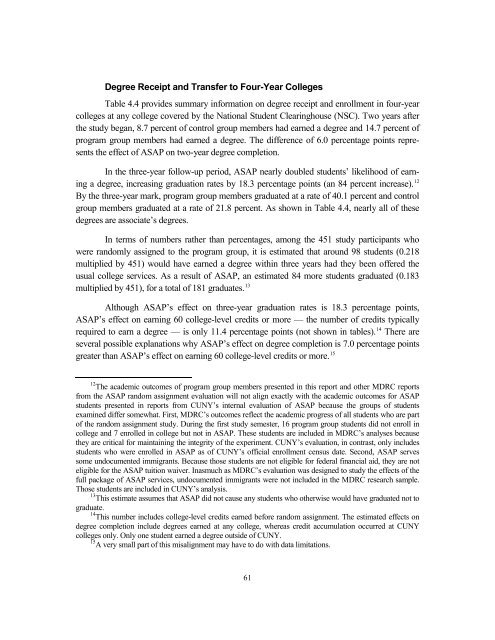1dOprzL
1dOprzL
1dOprzL
Create successful ePaper yourself
Turn your PDF publications into a flip-book with our unique Google optimized e-Paper software.
Degree Receipt and Transfer to Four-Year CollegesTable 4.4 provides summary information on degree receipt and enrollment in four-yearcolleges at any college covered by the National Student Clearinghouse (NSC). Two years afterthe study began, 8.7 percent of control group members had earned a degree and 14.7 percent ofprogram group members had earned a degree. The difference of 6.0 percentage points representsthe effect of ASAP on two-year degree completion.In the three-year follow-up period, ASAP nearly doubled students’ likelihood of earninga degree, increasing graduation rates by 18.3 percentage points (an 84 percent increase). 12By the three-year mark, program group members graduated at a rate of 40.1 percent and controlgroup members graduated at a rate of 21.8 percent. As shown in Table 4.4, nearly all of thesedegrees are associate’s degrees.In terms of numbers rather than percentages, among the 451 study participants whowere randomly assigned to the program group, it is estimated that around 98 students (0.218multiplied by 451) would have earned a degree within three years had they been offered theusual college services. As a result of ASAP, an estimated 84 more students graduated (0.183multiplied by 451), for a total of 181 graduates. 13Although ASAP’s effect on three-year graduation rates is 18.3 percentage points,ASAP’s effect on earning 60 college-level credits or more — the number of credits typicallyrequired to earn a degree — is only 11.4 percentage points (not shown in tables). 14 There areseveral possible explanations why ASAP’s effect on degree completion is 7.0 percentage pointsgreater than ASAP’s effect on earning 60 college-level credits or more. 1512 The academic outcomes of program group members presented in this report and other MDRC reportsfrom the ASAP random assignment evaluation will not align exactly with the academic outcomes for ASAPstudents presented in reports from CUNY’s internal evaluation of ASAP because the groups of studentsexamined differ somewhat. First, MDRC’s outcomes reflect the academic progress of all students who are partof the random assignment study. During the first study semester, 16 program group students did not enroll incollege and 7 enrolled in college but not in ASAP. These students are included in MDRC’s analyses becausethey are critical for maintaining the integrity of the experiment. CUNY’s evaluation, in contrast, only includesstudents who were enrolled in ASAP as of CUNY’s official enrollment census date. Second, ASAP servessome undocumented immigrants. Because those students are not eligible for federal financial aid, they are noteligible for the ASAP tuition waiver. Inasmuch as MDRC’s evaluation was designed to study the effects of thefull package of ASAP services, undocumented immigrants were not included in the MDRC research sample.Those students are included in CUNY’s analysis.13 This estimate assumes that ASAP did not cause any students who otherwise would have graduated not tograduate.14 This number includes college-level credits earned before random assignment. The estimated effects ondegree completion include degrees earned at any college, whereas credit accumulation occurred at CUNYcolleges only. Only one student earned a degree outside of CUNY.15 A very small part of this misalignment may have to do with data limitations.61


